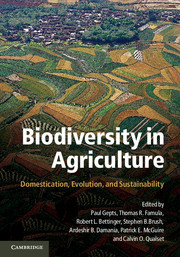Book contents
- Frontmatter
- Contents
- Tables
- Figures
- Foreword
- Contributors
- Acknowledgments
- Introduction: The Domestication of Plants and Animals: Ten Unanswered Questions
- 1 The Local Origins of Domestication
- Section I Early Steps in Agricultural Domestication
- Section II Domestication of Animals and Impacts on Humans
- Section III Issues in Plant Domestication
- 13 The Dynamics of Rice Domestication: A Balance between Gene Flow and Genetic Isolation
- 14 Domestication of Lima Beans: A New Look at an Old Problem
- 15 Genetic Characterization of Cassava (Manihot esculenta Crantz) and Yam (Dioscorea trifida L.) Landraces in Swidden Agriculture Systems in Brazil
- 16 Pigeonpea: From an Orphan to a Leader in Food Legumes
- Section IV Traditional Management of Biodiversity
- Section V Uses of Biodiversity and New and Future Domestications
- Index
- References
14 - Domestication of Lima Beans: A New Look at an Old Problem
Published online by Cambridge University Press: 05 June 2012
- Frontmatter
- Contents
- Tables
- Figures
- Foreword
- Contributors
- Acknowledgments
- Introduction: The Domestication of Plants and Animals: Ten Unanswered Questions
- 1 The Local Origins of Domestication
- Section I Early Steps in Agricultural Domestication
- Section II Domestication of Animals and Impacts on Humans
- Section III Issues in Plant Domestication
- 13 The Dynamics of Rice Domestication: A Balance between Gene Flow and Genetic Isolation
- 14 Domestication of Lima Beans: A New Look at an Old Problem
- 15 Genetic Characterization of Cassava (Manihot esculenta Crantz) and Yam (Dioscorea trifida L.) Landraces in Swidden Agriculture Systems in Brazil
- 16 Pigeonpea: From an Orphan to a Leader in Food Legumes
- Section IV Traditional Management of Biodiversity
- Section V Uses of Biodiversity and New and Future Domestications
- Index
- References
Summary
Crop domestication has been aptly considered by Jack Harlan (1992) as bringing wild-growing plants into the human household. This deep alteration of ecological relationships between the domestication-candidate and other biota in the novel and very different cultivated ecosystem – the domus – was eventually reflected in marked morpho-physiological and, hence, genetic differences between the domesticate and its wild progenitor. These differences, also labeled the domestication syndrome, concern primarily the organs and traits affected by human selection. They are often discrete and continuing, with a few loss-of-function ones (such as the lack of natural seed dispersal mechanisms). The end-point of this continuum (Pickersgill 2007) is full dependence of the domesticate on human activities for growth, reproduction, and long-term conservation.
The origin of domestication has interested scholars because it can be determined with some probability of success, unlike inquiries into the identity of the first farmers and their motivation and purpose for switching from hunting–gathering to agriculture. The question of origin of a crop can be seen from a double perspective: (i) the biological origin, that is, which wild plant gave rise to the crop through cultivation and selection; and (ii) the geographic origin, namely a particular region where this wild plant may have been domesticated. The domestication syndrome may provide clues pointing to the putative wild ancestor, because human selection affects plant part(s) of direct interest to humans, often fruits and seeds. In the case of Lima bean, this wild progenitor still exists, and its domestication syndrome has been discussed already (Smartt 1988, Pickersgill 2007).
- Type
- Chapter
- Information
- Biodiversity in AgricultureDomestication, Evolution, and Sustainability, pp. 330 - 343Publisher: Cambridge University PressPrint publication year: 2012
References
- 2
- Cited by



